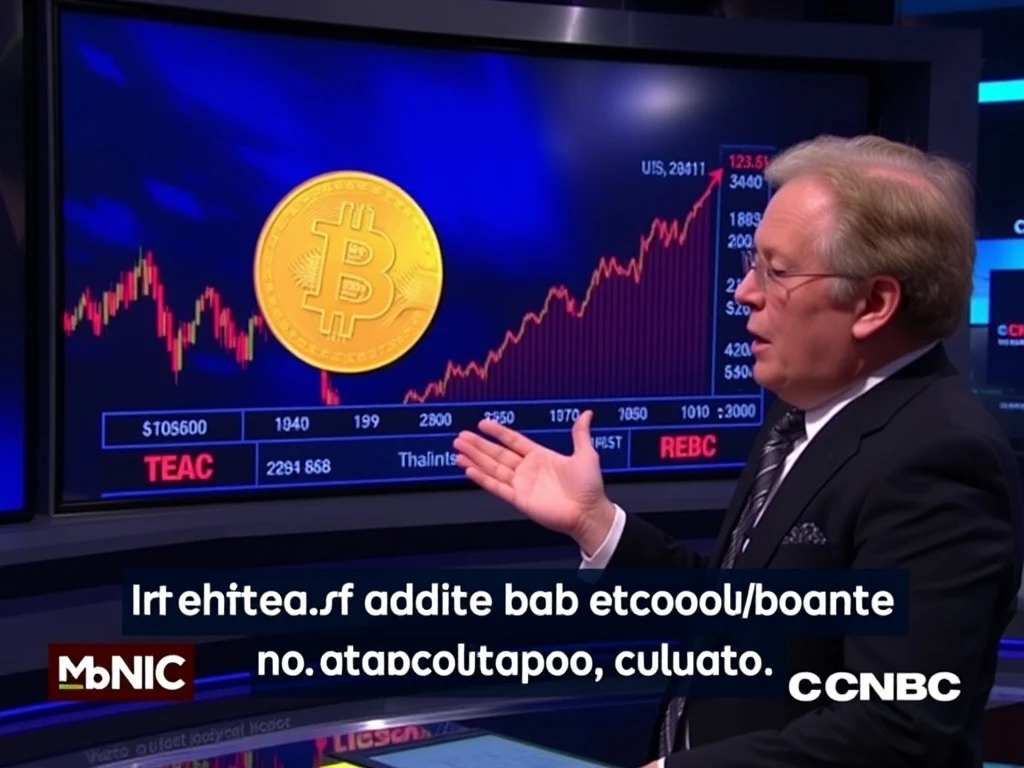Bitcoin: Jim Cramer’s Bold Move to Hedge Against $37 Trillion US Debt

In a significant shift that has caught the attention of both traditional finance and crypto enthusiasts, veteran Wall Street commentator and Mad Money host, Jim Cramer, has publicly announced an increase in his personal Bitcoin holdings. This isn’t just another investment; Cramer frames his decision as a strategic defense against the daunting reality of the escalating US debt, which now stands at an staggering $37 trillion. For those navigating uncertain economic waters, this move by a mainstream financial figure underscores a growing narrative: could Bitcoin truly be a robust hedge in an era of unprecedented fiscal expansion?
Jim Cramer’s Strategic Shift: Why Bitcoin?
Jim Cramer’s rationale for embracing Bitcoin is rooted in a pragmatic assessment of global economic stability. During a July 2025 CNBC segment, he articulated his belief that people are increasingly seeking alternatives to traditional assets, specifically as a safeguard against massive national debt. When asked if Bitcoin could withstand a financial crisis, his answer was a clear ‘Yes.’ His conviction stems from several core attributes of the cryptocurrency:
- Decentralized Structure: Unlike fiat currencies controlled by central banks, Bitcoin operates on a decentralized network, making it less susceptible to political manipulation or inflationary pressures caused by unchecked money printing.
- Capped Supply: With a hard cap of 21 million coins, Bitcoin‘s scarcity contrasts sharply with the unlimited potential for government-issued currency devaluation. This finite supply is a key argument for its long-term store of value potential.
- Long-Term Preservation: Cramer explicitly stated he’s acquiring Bitcoin for his children, indicating a focus on intergenerational wealth preservation rather than short-term trading. This long-term perspective aligns with the views of prominent crypto advocates like Anthony Pompliano, who has influenced Cramer’s evolving stance on digital assets.
The $37 Trillion Question: US Debt and Financial Uncertainty
The backdrop to Cramer’s Bitcoin accumulation is the intensifying debate surrounding the colossal US debt. Exceeding $37 trillion, this deficit raises serious concerns among economists and investors alike regarding:
- Inflationary Pressures: Large government spending, often financed by borrowing or quantitative easing, can lead to an increase in the money supply, potentially eroding the purchasing power of fiat currencies.
- Interest Rate Volatility: A ballooning national debt can put upward pressure on interest rates as the government competes with private borrowers for capital, impacting everything from mortgages to business loans.
- Fiscal Sustainability: The sheer scale of the debt raises questions about the long-term ability of the government to service its obligations without resorting to measures that could devalue the currency.
In this environment, traditional safe-haven assets are being re-evaluated. Cramer’s endorsement of Bitcoin aligns with a growing sentiment that conventional hedges might not fully address the unique risks posed by modern fiscal policies.
Is Crypto Hedge the New Gold?
For centuries, gold has been the go-to asset during times of economic uncertainty, revered for its scarcity and perceived stability. However, the rise of digital assets, particularly Bitcoin, has sparked a debate: could a crypto hedge offer a more effective shield against contemporary financial risks?
- Digital Scarcity vs. Physical: While gold is physically scarce, Bitcoin offers absolute digital scarcity, verifiable on its blockchain. This makes it immune to physical confiscation or debasement in the same way physical commodities might be.
- Portability and Divisibility: Bitcoin is easily transferable across borders and highly divisible, offering practical advantages over large physical gold holdings.
- Decentralized Resistance: Unlike gold, which can be influenced by government policies or market manipulation, Bitcoin‘s decentralized nature makes it more resistant to external control, appealing to those seeking true financial sovereignty.
Figures like Michael Saylor have championed large-scale Bitcoin accumulation as a defensive strategy against inflation and currency depreciation, further cementing its role in the crypto hedge narrative. While Bitcoin‘s volatility remains a point of contention for critics, its core properties are increasingly viewed as strengths in scenarios where fiat currencies face erosion of purchasing power.
Beyond Speculation: The Rise of Digital Assets in Portfolios
Cramer’s move signifies a broader shift in how institutional and mainstream investors perceive digital assets. What was once considered a niche, speculative play is now being seriously evaluated as a legitimate component of diversified portfolios. This evolving narrative reflects:
- Growing Institutional Acceptance: Major financial firms are increasingly exploring and offering crypto-related investment products, driven by client demand and a recognition of the underlying technology’s potential.
- Macroeconomic Relevance: Digital assets are no longer just about tech innovation; they are becoming intertwined with macroeconomic strategies, offering solutions to challenges posed by sovereign debt and inflationary pressures.
- Accessibility: With the proliferation of user-friendly platforms and regulated investment vehicles, accessing digital assets has become easier for both retail and institutional investors.
However, the integration of cryptocurrencies into mainstream portfolios remains a cautious journey, navigating complex regulatory landscapes and inherent market uncertainties. Cramer’s advocacy highlights this evolving intersection of technology, finance, and macroeconomic strategy, pushing the conversation forward.
Key Takeaways:
- Jim Cramer’s increased Bitcoin holdings are a direct response to the escalating $37 trillion U.S. federal debt.
- He views Bitcoin as a strategic, long-term hedge due to its decentralized nature and capped supply.
- This move reflects a growing institutional interest in digital assets as alternatives to traditional safe havens.
- The debate around US debt highlights concerns about inflation and fiscal sustainability, making alternative stores of value more appealing.
- While volatility exists, Bitcoin‘s unique properties position it as a potential crypto hedge against fiat currency devaluation.
Jim Cramer’s recent decision to significantly boost his Bitcoin holdings marks a pivotal moment in the ongoing integration of cryptocurrencies into mainstream financial thought. By framing Bitcoin as a vital hedge against the monumental $37 trillion US debt, he not only legitimizes its role but also contributes to a critical dialogue about financial stability in an era of unprecedented fiscal challenges. While the path for digital assets remains dynamic, influenced by regulatory shifts and market forces, Cramer’s endorsement provides a compelling case for considering Bitcoin‘s unique utility in mitigating macroeconomic risks. As investors continue to seek resilient strategies, the conversation around Bitcoin‘s place in a diversified portfolio will undoubtedly intensify, reflecting its growing prominence as a potential bulwark against traditional economic vulnerabilities.
Frequently Asked Questions (FAQs)
Q1: Why is Jim Cramer buying Bitcoin as a hedge against U.S. debt?
A1: Jim Cramer views Bitcoin as a strategic hedge against the U.S. national debt, which exceeds $37 trillion, due to its decentralized nature and capped supply of 21 million coins. He believes these characteristics make it a robust store of value against potential fiat currency devaluation caused by government spending and fiscal uncertainty.
Q2: What makes Bitcoin a potential “safe-haven” asset like gold?
A2: Bitcoin’s appeal as a safe-haven asset stems from its digital scarcity, decentralized network, and resistance to censorship. Unlike fiat currencies, its supply cannot be arbitrarily increased, similar to gold’s finite nature. Its global, permissionless transferability also offers advantages over physical assets.
Q3: Has Jim Cramer always been a proponent of Bitcoin?
A3: Jim Cramer’s stance on Bitcoin has evolved over time. Initially skeptical, his perspective shifted, partly influenced by discussions with crypto advocates like Anthony Pompliano. His recent actions indicate a strong conviction in Bitcoin’s long-term value and its role in wealth preservation.
Q4: How does the $37 trillion U.S. debt impact the economy?
A4: A massive U.S. national debt can lead to concerns about inflation, as increased government spending might devalue the currency. It can also put pressure on interest rates and raise questions about long-term fiscal sustainability, prompting investors to seek alternative assets to protect their purchasing power.
Q5: Are other institutional investors also considering Bitcoin as a hedge?
A5: Yes, figures like Michael Saylor and companies he leads have openly advocated for large-scale Bitcoin accumulation as a defensive strategy against inflation and currency depreciation. Jim Cramer’s move aligns with a broader trend of institutional curiosity and acceptance of digital assets as part of diversified investment strategies.
Q6: What are the main risks associated with using Bitcoin as a hedge?
A6: While Bitcoin offers unique benefits, its primary risk remains its price volatility. Regulatory uncertainties, potential technological vulnerabilities, and market sentiment shifts can also impact its value. Investors typically consider these factors when allocating Bitcoin to their portfolios.










